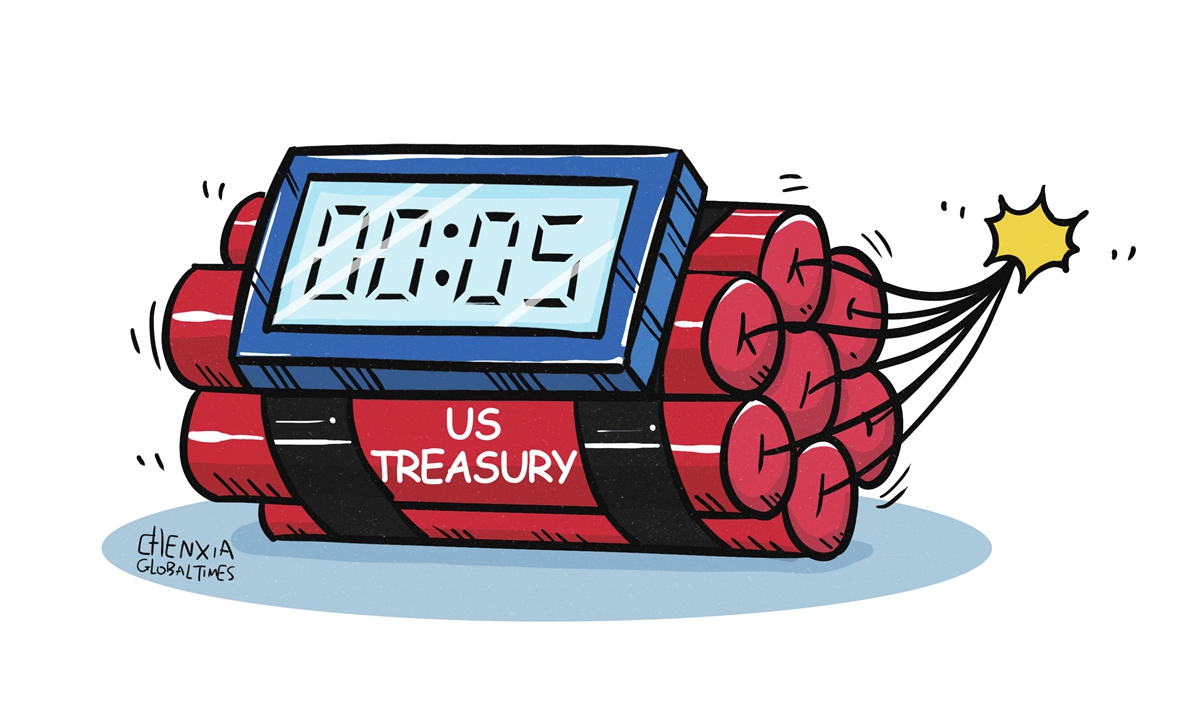
Illustration: Chen Xia/Global Times
The US policymakers seem to have steered the world's largest economy into unchartered territory, as it now faces multipronged challenges including persistently elevated inflation running at a 40-year high, a sputtering economy dragged down by a technical recession in the second quarter this year, and an enlarging federal debt which exceeded $31 trillion as of October 4 - a ticking time bomb for America and the world as well.
For the first time in history, the US' public debt outstanding has surpassed $31 trillion, data from the country's Treasury Department showed. A trillion dollars of debt was added in the past eight months alone, and it is close to reaching the $31.4 trillion debt ceiling that the US Congress set for the Biden administration's borrowing until early 2023.
Since Barack Obama took office in January 2009, the US' aggregate borrowings have kept galloping, with the current reading of $31 trillion nearly tripling $10.6 trillion worth of debt in early 2009. When Donald Trump came to the White House in early 2017, he inherited $19.9 trillion debt. And, when Biden took office in January 2021, the federal debt was $27.8 trillion. It is widely expected that the US national debt will hit a minimum of $50 trillion by 2030, according to estimations by some American institutions.
Like Japan, the US is increasingly becoming a heavily-indebted economy, with its national debt now accounting for approximately 140 percent of last year's GDP. Whether the US is going to face "two lost decades" of Japan-style anemic economic growth is unknown yet, but an incessantly bulging federal debt will definitely pose more problems for American policymakers, while chipping away at the US dollar's global reserve currency status, because a foundering US economy will inevitably reduce the importance of the greenback.
To make things worse, with inflation still running at more than 8 percent, the Federal Reserve has vowed to continue to raise interest rates in the coming months to tame stubborn price rises. Higher interest rates means that the US government will have to pay more for its huge borrowings, which raises questions about Washington's ability to service its debts, including the principal and increasingly larger interests.
As interest rates on US Treasury bonds rise, so will the federal government's borrowing costs. The US was able to borrow cheaply to respond to the COVID-19 pandemic because interest rates were at historically low in 2020. Now, interest rates on 20-year US Treasury bonds have grown to around 4 percent, meaning the US government will have to pay added interest costs of about $100 billion this year as the US central bank has raised rates from zero to 3-3.25 percent now. In May, the Congressional Budget Office (CBO) projected the US' annual interest costs will reach $399 billion this year, which is forecast to surge to $1.2 trillion in 2032.
The long-haul fiscal challenges facing the US are mounting. Since the 2008-09 global financial crisis, the US government has relied on quantitative easing (QE) monetary policy, through heavy borrowing from home and abroad, to maintain a relatively fast economic growth, in addition to maintain lavish spending on its military, medical care and other social welfare projects. However, the structural imbalance between spending and revenues that existed before the pandemic has been intensifying, causing American federal debt levels rapidly piling up.
If the US national debt exceeds $50 trillion, while its GDP struggles at around $25 trillion, then the world's largest economy will be truly thrust into a big trouble. US GDP this year is estimated to be flat against last year's figure. It may recede in 2023 and 2024, as the Fed's higher rates chip in, while Trump's tariffs war plus Biden's semiconductors tussle with China will further dim the US' economic prospects.
And, there will be fiercer and also uglier partisan fighting in Washington on congressional appropriations in the coming months, because the federal government will be constrained by the lawmakers and American public to borrow more to fund defense, infrastructure, education, medical care, elderly's pensions and other initiatives. For many years, US presidents, both Republican and Democratic parties, have avoided making hard choices about the budget, failing to put it on a sustainable path.
With a ballooning national debt and a struggling economy, the US policymakers will get to find that the global reserve currency of the dollar is set to erode, as the country's growing budget deficits will naturally raise concerns about the ability of Washington to pay back the debt. If the US government continues to sell more Treasury bonds or even parachuting printed money to American households and enterprises, investors will take caution and avoid buying the bonds. In the past several years, more central banks have begun to reduce their holdings of US dollar-denominated assets.
Once their faith in buying the US Treasury bonds is undermined, or if the US government further bundles its policies to cause a fiscal default one day, more foreign countries will join the rush to de-dollarize by dumping the US assets.
Is the Biden administration able to stop the US national debt from swelling? The chances are very slim. In 2021 and 2022, the US debt has expanded by more than $3.2 trillion under Biden's watch. The debt count is expected to surge to $35 trillion when Biden completes his current term in January 2025. So, the country's fiscal sustainability will draw more close scrutiny by investors both domestically and around the world.
The author is an editor with the Global Times. bizopinion@globaltimes.com.cn




